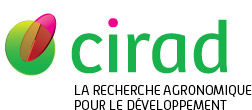Sow Gallo, Diarra Karamoko, Arvanitakis Laurence, Bordat Dominique. 2013. The relationship between the diamondback moth, climatic factors, cabbage crops and natural enemies in a tropical area. Folia Horticulturae, 25 (1) : 3-12.
|
Version publiée
- Anglais
Accès réservé aux personnels Cirad Utilisation soumise à autorisation de l'auteur ou du Cirad. document_567258.pdf Télécharger (1MB) |
Résumé : The impact of abiotic and biotic factors (rainfall, temperature, host plant and natural enemies) on population dynamics of the Plutella xylostella L. diamondback moth was investigated. The experiments were conducted during the rainy and dry seasons for two years (June 2009-April 2011) on unsprayed cabbage plots in Malika (Senegal). Every 10 days, 10 cabbages were randomly selected. Plutella xylostella larvae, pupae and parasitoid cocoons were recorded on each plant. Before each sampling, the diameters and ages of plants were recorded. Temperature and rainfall were also recorded during this study. Larvae and pupae of P. xylstella were higher for the dry season than the rainy season. There was a negative correlation between temperature and P. xylostella populations, and a strong relationship between P. xylostella populations and the age of cabbages. Females oviposited on young cabbages where the presence of young larvae was important, whereas older immature stages were mainly found in older cabbage plants. Parasitoid populations were higher for the dry season than the rainy season. High temperatures did not increase the pest populations and parasitism rate. There was no effect found on pest, plants and natural enemies due to rainfall. There was a positive correlation between pest populations and parasitism. Four Hymenoptera species were found: Oomyzus sokolowskii, Apanteles litae, Cotesia plutellae and Brachymeria citrae, but they were not efficient to control the P. xylostella populations. These results are important for understanding the factors that promote or inhibit pest populations and their natural enemies, and therefore essential for effective crop protection.
Mots-clés Agrovoc : Brassica, Plutella xylostella, facteur climatique, dynamique des populations, âge, température, agent de lutte biologique, Hymenoptera, parasitoïde, lutte antiravageur
Mots-clés géographiques Agrovoc : Sénégal
Classification Agris : H10 - Ravageurs des plantes
P40 - Météorologie et climatologie
Champ stratégique Cirad : Axe 1 (2005-2013) - Intensification écologique
Auteurs et affiliations
- Sow Gallo, UCAD (SEN)
- Diarra Karamoko, UCAD (SEN)
- Arvanitakis Laurence, CIRAD-PERSYST-UPR HortSys (FRA)
- Bordat Dominique, CIRAD-PERSYST-UPR HortSys (FRA)
Source : Cirad - Agritrop (https://agritrop.cirad.fr/567258/)
[ Page générée et mise en cache le 2024-01-28 ]




